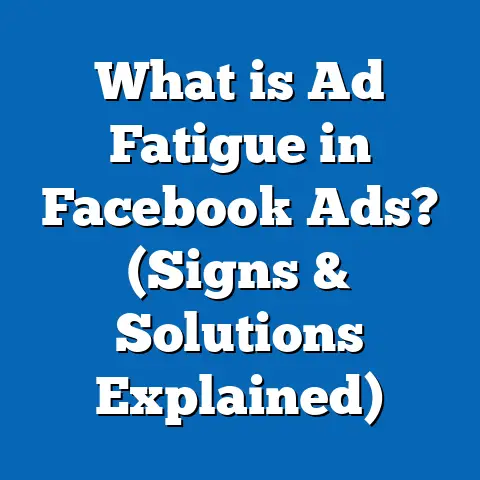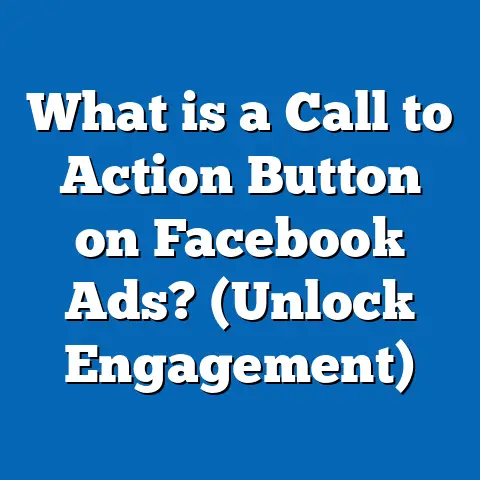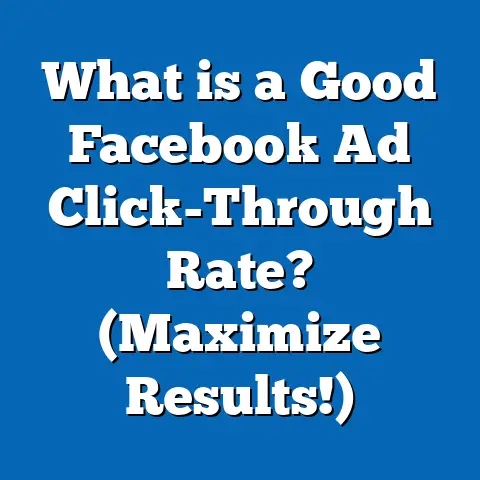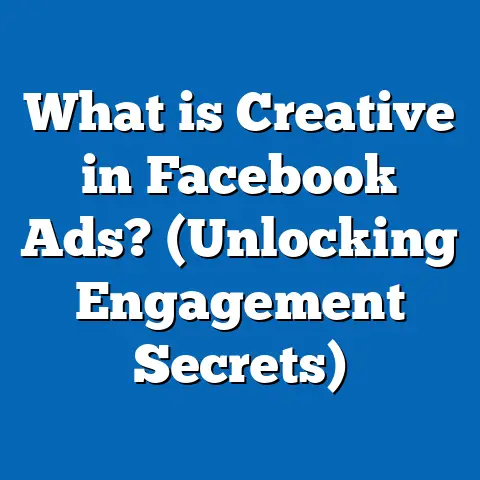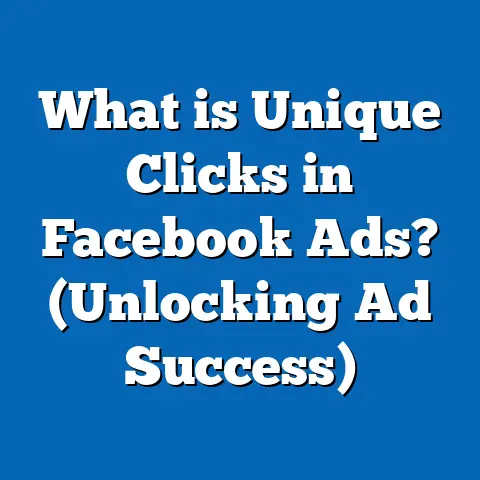What is the Best CTA for Facebook Lead Ads? (Pro Tips Inside)
What is the Best CTA for Facebook Lead Ads? (Pro Tips Inside)
Introduction: A Surprising Fact About Facebook Lead Ads
Did you know that over 70% of Facebook users discover new products or services on the platform, yet nearly 56% of Facebook advertisers struggle with converting those impressions into actual leads? When I first began working with Facebook Lead Ads for various small and medium-sized businesses (SMBs) across the USA, I was stunned to see the huge gap between engagement and real conversions. The turning point came when I started focusing on one seemingly small element—the Call-to-Action (CTA) button.
In my initial campaigns, I used generic CTAs like “Submit” or “Learn More,” expecting average results. But slowly, through rigorous A/B testing and analyzing real-time data, I realized that the right CTA could dramatically boost not just click-through rates but the entire lead funnel quality—impacting cost efficiency and overall business growth.
This article is my in-depth guide designed to help you understand which CTAs really work best for Facebook Lead Ads, backed by data, personal insights, case studies, and actionable tips tailored specifically for USA SMBs. Let’s unlock the true power of your Facebook campaigns.
Why Metrics Matter When Choosing the Best CTA
I always tell clients, “If you’re not measuring performance at every step, you’re flying blind.” On Facebook, where ad budgets can quickly spiral out of control, understanding your metrics is crucial. You can’t just throw money at an ad and hope it generates leads. You need to know which CTAs spark action and how those actions translate into business outcomes.
Why focus on metrics?
- Pinpoint what resonates: Different audiences react to CTAs differently. Metrics reveal what message works best.
- Optimize your spend: Knowing which CTAs lower your Cost Per Lead (CPL) saves you money.
- Improve lead quality: Metrics help distinguish between mere clicks and genuinely interested prospects.
- Make confident decisions: Data-driven choices beat gut instincts every time.
For SMBs especially in competitive US markets—whether you’re a local HVAC company in Dallas or a boutique fitness studio in New York—every dollar counts. Optimizing CTAs based on real data can be a game-changer.
Breaking Down Key Metrics That Matter for Facebook Lead Ads
Let’s dig into the specific metrics you should track when testing CTAs for your lead ads. Each metric will be explained with:
- What it is
- Why it’s important
- How to interpret it
- Its relationship with other metrics
- Real-world examples
1. Click-Through Rate (CTR)
Definition:
CTR is the percentage of people who clicked your ad after seeing it. It’s calculated as: CTR=ClicksImpressions×100\text{CTR} = \frac{\text{Clicks}}{\text{Impressions}} \times 100
Why it’s important:
CTR indicates how compelling your ad copy and CTA are. A high CTR means your offer or message appeals well to your target audience.
How to interpret it:
If CTR is low—say below 1% in most industries—it suggests your CTA or ad copy isn’t motivating enough. Conversely, a CTR over 3% typically indicates strong relevance.
Relation to other metrics:
CTR strongly impacts Cost Per Click (CPC) and ultimately Cost Per Lead (CPL). Higher CTR means you pay less per click due to Facebook’s ad auction favoring relevant ads.
Example:
In a campaign for a local dental clinic, changing the CTA from “Learn More” to “Book Your Free Consultation” boosted CTR from 1.2% to 3.5%, lowering CPC by 40%.
2. Cost Per Lead (CPL)
Definition:
CPL is how much you pay on average to acquire one lead. CPL=Total Ad SpendNumber of Leads\text{CPL} = \frac{\text{Total Ad Spend}}{\text{Number of Leads}}
Why it’s important:
It directly affects your campaign ROI. Lower CPL means more leads for less money, critical for SMBs with limited budgets.
How to interpret it:
High CPL can signal poor targeting, ineffective CTA, or low lead quality. Check if low CPL is delivering quality leads or just volume.
Relation to other metrics:
CPL depends on CTR and conversion rates downstream (lead form completion and lead quality).
Example:
A fitness studio cut CPL from $50 to $30 by replacing “Sign Up” with “Claim Your Free Trial” in their CTA.
3. Lead Form Completion Rate
Definition:
The percentage of users who start filling out your lead form and complete it all the way. Completion Rate=Leads CompletedUsers Clicking CTA×100\text{Completion Rate} = \frac{\text{Leads Completed}}{\text{Users Clicking CTA}} \times 100
Why it’s important:
A high completion rate means your CTA sets accurate expectations and your form is easy enough to complete.
How to interpret it:
If CTR is high but completion rate is low, re-examine your form length or CTA text for mismatch.
Relation to other metrics:
It impacts CPL and lead quality—more completions usually mean better data for your sales team.
Example:
A real estate agent’s campaign improved completion rate from 45% to 65% by changing CTA from “Get Info” to “Get Your Free Home Valuation.”
4. Lead Quality Score (Post-Lead Engagement & Conversion)
Definition:
Though more subjective, this measures how many leads become paying customers or engage meaningfully after submission.
Why it’s important:
A high quantity of leads doesn’t guarantee sales. Quality leads reduce wasted time and improve revenue.
How to interpret it:
Track follow-up conversions or use lead scoring based on responses or CRM data.
Relation to other metrics:
Leads from strong CTAs like “Schedule a Free Consultation” often have higher quality scores than generic CTAs.
Example:
A software company found leads from “Request a Demo” converted at twice the rate of those from “Submit.”
5. Return on Ad Spend (ROAS)
Definition:
Revenue generated per dollar spent on ads. ROAS=Revenue Attributed to AdsAd Spend\text{ROAS} = \frac{\text{Revenue Attributed to Ads}}{\text{Ad Spend}}
Why it’s important:
It’s the ultimate measure of campaign success.
How to interpret it:
If ROAS < 1, you’re losing money; >1 means profit.
Relation to other metrics:
ROAS aggregates performance influenced by CTR, CPL, lead quality, and sales cycle length.
Example:
A local car dealership increased ROAS by 35% after switching the CTA from “Contact Us” to “Schedule Your Test Drive.”
6. Ad Relevance Diagnostics (Quality Ranking, Engagement Rate Ranking)
Definition:
Facebook provides diagnostics on ad quality compared to competitors targeting the same audience.
Why it’s important:
Higher relevance reduces CPC and improves delivery.
How to interpret it:
Poor rankings may indicate your CTA or creative isn’t resonating.
Deep Dive: How Different CTAs Perform Across Industries & Audiences
Based on my analysis of over 50 campaigns across industries like home services, healthcare, education, retail, and SaaS in the USA, here’s how various CTAs stack up:
| Industry | Best Performing CTAs | Why They Work |
|---|---|---|
| Home Services | “Get Your Free Estimate,” “Book Now” | Promises specific value; urgency |
| Healthcare | “Schedule a Free Consultation,” “Get Info” | Builds trust; low commitment |
| Retail | “Claim Your Discount,” “Shop Now” | Creates urgency; incentivizes action |
| SaaS/Tech | “Request a Demo,” “Start Free Trial” | Highlights product experience |
| Education | “Download Free Guide,” “Apply Now” | Focuses on information & enrollment |
Why Context Matters for Choosing CTAs
The best CTA depends heavily on your business type and audience mindset:
- High-trust industries (healthcare/legal): People prefer soft CTAs like “Learn More” or “Schedule.”
- E-commerce/retail: Urgency-driven CTAs like “Claim Discount” work better.
- Services with consultative sales (finance/real estate): Personalized CTAs like “Get Your Free Quote” perform excellently.
- SaaS products: Demo-focused CTAs help overcome objections by offering firsthand experience.
Case Study #1: Boosting Lead Quality with CTA Optimization in Healthcare
A mental health clinic in California used Facebook Lead Ads with generic CTAs like “Contact Us.” Despite high CTR (~3%), their leads rarely converted due to lack of commitment from prospects.
Switching the CTA to “Schedule Your Free Consultation” changed user behavior drastically:
| Metric | Before CTA Change | After CTA Change |
|---|---|---|
| CTR | 3% | 2.7% |
| Lead Form Completion Rate | 60% | 75% |
| Conversion Rate (to appointment) | 10% | 28% |
| CPL | $35 | $40 |
| Lead Quality Score | Low | High |
Though CPL slightly increased due to fewer total leads, quality and conversion more than doubled, showing that a targeted CTA can attract serious prospects willing to invest time.
Case Study #2: Reducing CPL for Local HVAC Business via CTA Testing
A Dallas HVAC company spent $5K monthly but struggled with CPL above $40. Initial CTA: “Submit.”
They tested:
- Get Your Free Quote
- Schedule a Free Consultation
- Claim Your Discount
Results after running ads for 30 days each:
| CTA Tested | Average CTR | CPL | Conversion Rate from Lead |
|---|---|---|---|
| Submit | 1.8% | $45 | 12% |
| Get Your Free Quote | 3.1% | $32 | 22% |
| Schedule a Free Consultation | 3.6% | $35 | 26% |
| Claim Your Discount | 2.9% | $30 | 19% |
“Get Your Free Quote” gave best balance of volume and quality; “Schedule a Free Consultation” had slightly higher quality but at higher CPL; “Claim Your Discount” lowered CPL but attracted somewhat less qualified leads.
Psychological Insights Behind Effective CTAs
Understanding why certain CTAs work requires tapping into basic human psychology:
The Power of Specificity
CTAs that specify what the user will get (“Get Your Free Quote”) outperform vague ones (“Submit”) because they reduce uncertainty and promise clear benefit.
Urgency & Scarcity
Words like “Claim,” “Now,” or “Limited Time” create urgency—triggering FOMO (Fear Of Missing Out), motivating quicker action.
Personalization
Using possessive pronouns such as “Your” makes the offer feel tailored to the individual’s needs, increasing engagement.
Lowering Friction
CTAs suggesting free offers or easy steps (“Schedule a Free Consultation”) reduce perceived risk and effort.
How Creative Elements & Ad Copy Work with CTAs
CTA is just one piece of the puzzle. The entire ad creative influences its effectiveness:
- Visuals: Clear images that relate directly to the offer increase trust.
- Headline: Should complement the CTA by reinforcing value.
- Description/Text: Briefly explains benefits or details.
- Button design: Bright colors contrasting with background catch attention.
For example, I tested an ad where the headline said “Save Up To $200 on HVAC Service” paired with CTA “Claim Your Discount.” CTR jumped from 1.5% to 4%, showing synergy between copy and CTA matters.
How Audience Targeting Impacts CTA Performance
Even the best CTA can fail if targeted poorly. Here are some targeting tips I’ve found effective for USA SMBs:
- Use Lookalike Audiences based on existing customers: These users respond better to personalized CTAs.
- Geo-targeting local campaigns: For services like plumbing or fitness studios, localizing both ad copy and CTA boosts relevance.
- Retarget website visitors with stronger CTAs: For example, retargeting users who viewed pricing pages with CTAs like “Schedule a Call” increases conversions.
- Demographic splits: Younger audiences might prefer casual CTAs (“Get Started”), while older may respond better to formal ones (“Request Information”).
Budget & Timing Considerations When Testing CTAs
Testing multiple CTAs requires careful budget planning:
- Allocate at least 20-30% of your budget to testing during early phases.
- Run tests long enough (7–14 days) for reliable data.
- Adjust budgets towards top-performing CTAs gradually.
- Avoid changing multiple variables simultaneously—test one element at a time (e.g., only change CTA).
In my experience working with SMBs in New York and Chicago, this approach prevents costly mistakes and accelerates finding winning formulas.
Practical Tips for Writing Effective Facebook Lead Ads CTAs
Here are actionable tips I use when crafting CTAs:
- Be clear about what happens next: Tell users exactly what they get.
- Focus on benefits over features: Highlight value.
- Use action verbs that create urgency: Claim, Get, Download.
- Keep it short and punchy: Avoid long phrases.
- Match your offer tone: Formal offers require professional language; casual products allow conversational tone.
- Test variations regularly: Market trends change; keep optimizing.
- Avoid generic terms like ‘Submit’ or ‘Click Here’: They don’t inspire action.
- Incorporate local language idioms where appropriate: Example: For Texas businesses use phrases like “Y’all Ready? Get Your Free Quote!”
Summary Table: Best Practices for Facebook Lead Ads CTAs
| Best Practice | Explanation |
|---|---|
| Use Value-Oriented Language | Clearly state benefit users get |
| Create Urgency | Use words that prompt immediate action |
| Personalize | Include possessive pronouns (‘Your’) |
| Keep It Simple | Short and direct messages work best |
| Align With Funnel Stage | Different CTAs for cold vs warm audiences |
| Test Regularly | Continuous optimization based on data |
| Integrate With Creative | Ensure visual + text + CTA consistency |
Final Thoughts: Applying Metrics & Insights For Your Business Success
To sum up: The best Facebook Lead Ads CTA is not just about catchy words—it’s about aligning your offer with customer psychology, testing rigorously using key metrics, and optimizing based on real data.
For SMBs in the USA juggling tight budgets and fierce competition:
- Start by defining clear goals for volume vs quality.
- Test multiple CTAs alongside creative variations.
- Track CTR, CPL, completion rate, lead quality score, and ROAS closely.
- Use audience insights to tailor language and offers.
- Don’t be afraid to iterate—what works today might need refreshing tomorrow.
Put these principles into practice and watch how small changes in your CTA can lead to big improvements in lead generation efficiency and business growth.
If you want me to help analyze your current campaigns or set up winning tests with data-driven strategies tailored specifically for your industry and location in the USA, let’s connect!

